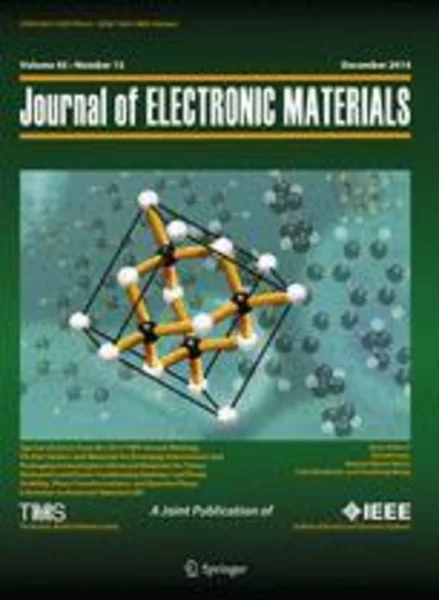-
an x-ray radiography study of the effect of thermal cycling on damage evolution in large-area sn-3.5ag solder joints
جزئیات بیشتر مقاله- تاریخ ارائه: 1392/07/24
- تاریخ انتشار در تی پی بین: 1392/07/24
- تعداد بازدید: 802
- تعداد پرسش و پاسخ ها: 0
- شماره تماس دبیرخانه رویداد: -
there is a need for next-generation, high-performance power electronic packages and systems utilizing wide-band-gap devices to operate at high temperatures in automotive and electricity transmission applications. sn-3.5ag solder is a candidate for use in such packages with potential maximum operating temperatures of about 200°c. however, there is a need to understand the thermal cycling reliability of sn-3.5ag solders subject to such high-temperature operating conditions. the results of a study on the damage evolution occurring in large-area sn-3.5ag solder joints between silicon dies and direct bonded copper substrates with au/ni-p metallization subject to thermal cycling between 200°c and 5°c are presented in this paper. interface structure evolution and damage accumulation were followed using high-resolution x-ray radiography, cross-sectional optical and scanning electron microscopies, and x-ray microanalysis in these joints for up to 3000 thermal cycles. optical and scanning electron microscopy results showed that the stresses introduced by the thermal cycling result in cracking and delamination at the copper–intermetallic compound interface. x-ray microanalysis showed that stresses due to thermal cycling resulted in physical cracking and breakdown of the ni-p barrier layer, facilitating cu-sn interdiffusion. this interdiffusion resulted in the formation of cu-sn intermetallic compounds underneath the ni-p layer, subsequently leading to delamination between the ni-rich layer and cu-sn intermetallic compounds.
مقالات جدیدترین رویدادها
-
استفاده از تحلیل اهمیت-عملکرد در ارائه الگوی مدیریت خلاقیت سازمانی و ارائه راهکار جهت بهبود
-
بررسی تاثیر ارزش وجوه نقد مازاد بر ساختار سرمایه شرکت های پذیرفته شده در بورس اوراق بهادار تهران
-
بررسی تأثیر سطح افشای ریسک بر قرارداد بدهی شرکت های پذیرفته شده در بورس اوراق بهادار تهران
-
بررسی تأثیر رتبه بندی اعتباری مبتنی بر مدل امتیاز بازار نوظهور بر نقد شوندگی سهام با تأکید بر خصوصی سازی شرکت ها
-
تأثیر آمیخته بازاریابی پوشاک ایرانی بر تصویر ذهنی مشتری پوشاک ایرانی (هاکوپیان)
-
بررسی فرآیندهای ژئوشیمیایی حاکم بر کیفیت آب زیرزمینی آبخوان عقیلی، استان خوزستان
-
مطالعه و بررسی آزمایش های مربوط به بتن خود متراکم (scc) در فاز خمیری و تفسیر نتایج بدست آمده
-
مقایسه عددی رفتار ستون های cfst و srcfst تحت بارهای متناوب
-
بررسی تاثیر تقلب در اعتبار اسنادی صادره از بانک ها در حقوق ایران
-
تحلیل پایداری چاه توسط معیارهای شکست مور – کلمب و موگی – کلمب در یکی از مخازن جنوب غرب ایران
مقالات جدیدترین ژورنال ها
-
مدیریت و بررسی افسردگی دانش آموزان دختر مقطع متوسطه دوم در دروان کرونا در شهرستان دزفول
-
مدیریت و بررسی خرد سیاسی در اندیشه ی فردوسی در ادب ایران
-
واکاوی و مدیریت توصیفی قلمدان(جاکلیدی)ضریح در موزه آستان قدس رضوی
-
بررسی تاثیر خلاقیت، دانش و انگیزه کارکنان بر پیشنهادات نوآورانه کارکنان ( مورد مطالعه: هتل های 3 و 4 ستاره استان کرمان)
-
بررسی تاثیر کیفیت سیستم های اطلاعاتی بر تصمیم گیری موفق در شرکتهای تولیدی استان اصفهان (مورد مطالعه: مدیران شرکتهای تولیدی استان اصفهان)
-
بررسی اثر بخشی فناوری اطلاعات بر عملکرد مدیران مدارس شهرستان لردگان
-
مطالعه ای بر تاثیر رسانه های اجتماعی در تشویق و ترغیب مردم برای مشارکت در انتخابات ریاست جمهوری 1400
-
تراداستان و سفر تراداستانی: گونه ها و کاربست ها
-
spatial analysis of quality of life in economic dimension of villages of lahijan town
-
a comparative study of the carbonyl positioning mechanism in the mn (co) 5 ch2f and mn (co) 5chf2 complex through quantum chemistry




سوال خود را در مورد این مقاله مطرح نمایید :